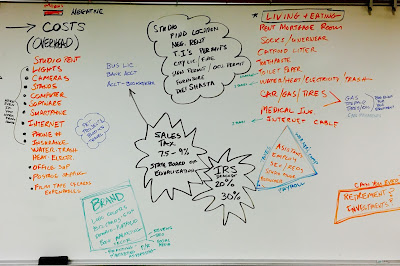Here are the notes from 455B/C class from the freelance business income and expense lecture.
The photos should enbiggen when clicked.
Why $52,000 a year? Because it's easy math: One job every week. The basic premise is that you earn $1000 every week for all 52 weeks a year (one $1000 job or four $250 jobs). Some weeks you'll do more, and some you'll do fewer, but that's an easy number to examine on average. If you want to make $104,000 a year, you'll need to charge double or do two jobs a week. If you have a day job, you may only have half the income per week from your photography. Depending on the type of work you do, those jobs could take a couple hours to complete or a full day or they might take planning, scouting, pre-production, travel, setup, shoot, strike, travel, post production, editing, retouching, uploading and delivery that take seven days for one project.
 |
$52K a year in income... $1000 job every week, it's week seven of class,
have you done seven jobs at $1000 each this year? |
Editorial rates (magazine work) are usually the lowest but allow you to resell your images to multiple outlets and stock. Advertising and Fashion are hard to break into but have high day-rates. Stock photo sales of previous jobs are a good way to bring in extra cash from finished projects that another client already paid for or editorial outtakes, or you could focus on making stock images "on Spec" that you feel would be popular and hope they sell enough to pay for your time and expenses and also make a profit. Weddings and Family portrait studios can get contracts for school portraits and seniors that bring in a known income over the school year but these are fiercely competitive. Family portrait studios can also build long term relationships over twenty years and photograph the generational "Family Circle." Senior portrait > begets engagement photo > begets wedding photo > begets new baby photo > begets family portrait > begets senior portrait > lather > rinse > repeat. The Family Circle was more prevalent 20 years ago but if a studio photographer can build a long-term family relationship that is strong enough, it still works.
 |
From cameras to coffee filters.
OVERHEAD is the costs, taxes, fees and expenses that it takes to run a business. |
On the cost side of the equation, if a photographer's GROSS income is $52K then there are a million ways to spend that income on OVERHEAD. Everything from the big ticket items: Studio Rent, Equipment, Marketing, Insurance and Taxes to the small stuff: toilet paper, gaff tape, paper clips and monthly charges like utilities, internet, mobile phone, software, and memberships.
The difference between the GROSS $52,000 that you make and the costs, expenses, overhead that you pay to run your studio is your NET income. In other words NET income is the money left over after all the expenses and taxes are paid. When photographers brag "I made $200,000 dollars last year!" I like to ask, "Is that NET?" As photographers we can easily spend most of the income from our career on expenses like getting new clients and buying new fancy cameras and lights. If you make $52,000 GROSS a year, you'll soon see how easy it is to spend $42,000 per year on OVERHEAD, leaving you a NET of $10K.
If you work all year for a $10K NET you could calculate that in hours (The standard American 40 hour x 52 weeks = 2080 hours). You'll find your hourly wage is $4.80 per hour with no benefits, retirement or healthcare. Even that fancypants photographer that "Made $200,000 last year," may have only had a NET income of $20,000 (and that's about minimum wage).









